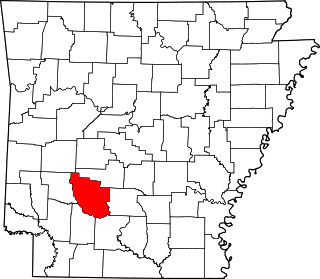
Philander Smith College is a private historically black college, in Little Rock, Arkansas. Philander Smith College is affiliated with the United Methodist Church and is a founding member of the United Negro College Fund (UNCF). Philander Smith College is accredited by the North Central Association of Colleges and Schools.

Arkansas Baptist College (ABC) is a private, historically black liberal arts college in Little Rock, Arkansas. Founded in 1884 as the Minister's Institute, ABC was initially funded by the Colored Baptists of the State of Arkansas. It is the only historically black Baptist school west of the Mississippi River. The Main Building on its campus, built in 1893, is one of the oldest surviving academic buildings in the state, and was listed on the National Register of Historic Places in 1976.
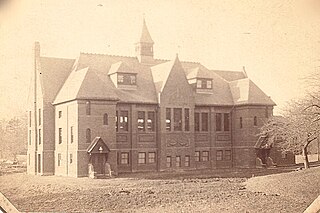
The Smith Alumnae Gymnasium is a historic former athletic facility on the Smith College campus in Northampton, Massachusetts. Located facing Burton Lawn, it was built in 1890 as a fine addition to the adjacent Gothic style buildings. The building now houses the college's archives, and was connected by the adjacent Neilson Library by a bridge in 1982. It is the first place in which a formal women's basketball game was played, in 1892, and is one of the first American athletic facilities built specifically for women. The building was listed on the National Register of Historic Places in 1976.

The University of Arkansas Campus Historic District is a historic district that was listed on the National Register of Historic Places on September 23, 2009. The district covers the historic core of the University of Arkansas campus, including 25 buildings.

Phoenix Union High School was a high school that formed part of the Phoenix Union High School District in Phoenix, Arizona.

The Eddie Mae Herron Center & Museum is a historic community building at 1708 Archer Street in Pocahontas, Arkansas. Originally built as an African Methodist Episcopal Church, it is a small one-room wood frame structure, with a gable roof and novelty siding. A flat-roof addition expands the building to the right. The main facade has two entrances, each sheltered by a small gable-roofed hood. The building was built in 1918, to provide facilities for a church and school to the small African-American community in Pocahontas. It served as a church for thirty years, and as a school for fifty, and was later adapted for other uses, most recently as a museum and community center.

Okolona College, also known as Okolona Industrial School, and Okolona Normal & Industrial School, was a college for African Americans in Okolona, Mississippi, Chickasaw County, Mississippi. It was added to the National Register of Historic Places on August 9, 2002. The school is located on Mississippi Highway 245 1.1 miles north of the junction with Mississippi Highway 32 and Mississippi Highway 41. It is part of The Okolona College Historic District.

The Wortham Gymnasium was a historic athletic facility on Arkansas Highway 200 in Oak Grove, a rural community in Nevada County east of Rosston. Built in 1935 by a Works Progress Administration crew, this large gymnasium was the only surviving remnant of a major push in the 1920s and 1930s to improve the education of African Americans in Oak Grove. It was a single-story wood-frame structure with a gable roof, with a shed-roofed vestibule area on the main (southern) facade. At the time of its construction, it was the largest gymnasium in the state.

The Magnolia Colored School Historic District encompasses the historic Magnolia Colored School, a school facility serving the African-American population of Magnolia, Arkansas, between 1915 and 1969. It occupies a city block bounded by Madison, School, and Ross Streets, and includes four buildings built between c. 1940 and 1965. The main building, the Magnolia Colored High School, is a single-story building with Plain-Traditional styling built in 1948 after a fired destroyed the 1940 building. The complex also includes an auditorium, shop building, and home economics building. The c. 1940 shop and home economics buildings survived the 1948 fire, but the shop was torn down in 1964 to make way for the auditorium, and a new shop building was also built. In 1950 the school's name was changed to Columbia County High School, and was also known for a time as Columbia High School. A grade school, cafeteria, and gymnasium which were all originally part of the complex were torn down between 1994 and 2000.
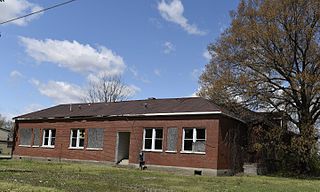
The Marion Colored High School is a historic school building at the northwest corner of Arkansas Highway 77 and Gannt Street in Sunset, Arkansas. It is a single-story brick structure, roughly in an H shape, with hipped roofs on the wings. The oldest portion of the building, a U-shaped section, was built in 1924 with funding from the Rosenwald Fund, and was extended to its present shape sometime before 1940. The original construction is of load-bearing brick, while the added wings are frame construction finished in a matching brick veneer. It was the first school built for African-American students in the area, originally serving grades 1-8. In 1937 the school acquired high school status, and served students from four states in the region, prompting its enlargement. In 1955 it was remodeled for use exclusively as a high school. It is now closed, and only used for special events.

The Bruno School Building is a historic school building a short way south of Arkansas Highway 9 in Bruno, Arkansas. It is a single story Plain Traditiona frame structure, with a gable roof and a front porch with gabled pediment. Built in 1920, it has some Craftsman style influence, including exposed rafter tails and the square columns on stone piers which support the porch. It is a locally significant well-preserved example of a rural school building.
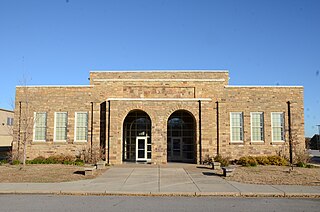
The Greenwood Gymnasium is a historic school building at 300 East Gary Street, on the campus of the Greenwood High School in Greenwood, Arkansas. It is a large brick building, housing two classrooms, a gym space with bleachers and a stage, and locker rooms for boys and girls. Its lobby is accessed via an entrance recessed behind a pair of round arches. The gymnasium was built in 1938-39 with funding from the Works Progress Administration, and is a well-preserved and durable example of that project's work.
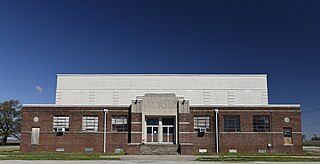
The Wilson High School Gymnasium is a historic school athletic facility at Main and Lee Streets in Wilson, Arkansas. Built in 1948 and used until 1965, this large single-story Art Deco brick building is a remarkably well-preserved facility, with original floors, bleachers, and equipment such as basketball hoops and scoreboards. The pool at the rear of the building retains original tile work.

The Redfield School Historic District encompasses a Depression-era school complex at 101 School Street in Redfield, Arkansas. The main building of the complex is an H-shaped single-story brick building, with a dormered gable roof. Additional buildings on the campus include a carriage house dating to the 1910s, when the first school was built on the site, and a 1950s-era gable-roofed gymnasium. It also includes the athletic fields that lie adjacent to the school. The school building, built in 1939 with funding from the Works Progress Administration, was the only project of the New Deal in Redfield. The district was listed on the National Register of Historic Places in 1975.

The Carver Gymnasium is a historic school building at 400 Ferguson Street in Lonoke, Arkansas. It is a vernacular single-story structure, built out of concrete blocks and capped by a gabled metal roof. The gable ends are clad in metal siding, and there are irregularly spaced awning windows on the walls. It was built in 1957 for the Carver School, the segregated facility serving Lonoke's African-American students, and is its last surviving building. After the city's schools were integrated in 1970, the school complex served as its junior high school, and was vacated by the school system in 2005.

The Guy High School Gymnasium is a historic school building on the campus of the Guy-Perkins District School System on Arkansas Highway 25, just east of Guy, Arkansas. It is a single story stone structure, with a gabled rood and four brick chimneys. Two gabled porches project from the front side, near the corners, each supported by stone columns and featuring stuccoed pediments. It was built by local labor with funding support from the Works Progress Administration in 1938.

The Guy Home Economics Building is a historic school building on the campus of the Guy-Perkins School District, east of Guy, Arkansas. It is a single story stone structure, with a gabled roof that features exposed rafter ends and large Craftsman brackets at the gable ends. A single-story gabled porch, with an arched opening, shelters the main entrance. It was built in 1936 with funding support from the Works Progress Administration.

The Menifee High School Gymnasium is a historic school building at North Park and East Mustang Streets in Menifee, Arkansas. It is a single-story frame structure, its exterior finished in uncoursed fieldstone veneer. It has a gabled roof with exposed rafter ends, and two entry pavilions with gable roofs supported by stone posts. It was built in 1938 with funding support from the Works Progress Administration, and was one of the first three WPA-funded athletic facilities built specifically for a segregated African-American school.
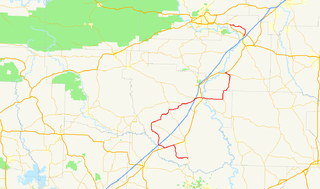
Highway 51 is a designation for two north–south state highways in Southwest Arkansas. One route of 53.37 miles (85.89 km) begins Highway 53 near Whelen Springs and runs north to US Highway 67 in Donaldson. A second route of 7.92 miles (12.75 km) runs parallel to US 270 northwest of Malvern. Both routes are maintained by the Arkansas Department of Transportation (ArDOT).

The Arcadia Colored High School was a high school for African-American students in Arcadia, Louisiana. It was originally known as Bienville Parish Training School and was later known as Crawford High School. It eventually was a campus of 10 buildings.





